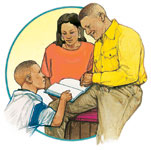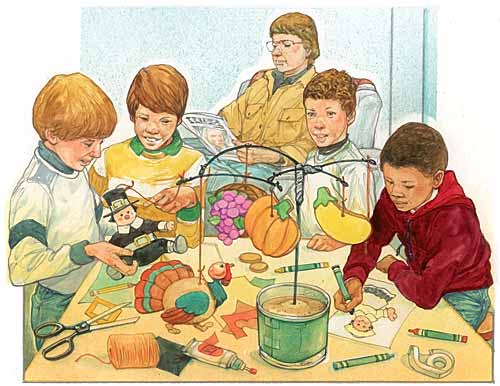
Helping Children Do Their Best on Group Projects
By Kris Imherr
Illustration by Joel Snyder
Adults can actively assist in raising the comfort level and performance abilities of their kids and other group members.
The Cartiers of Dallas, Texas, long ago established a homework routine. While it doesn't work perfectly, the three kids, Christina, 16; T. J., 13; and Kevin, 12, usually manage their after-school duty of doing math problems, studying spelling, reviewing vocabulary, and working on such other individual assignments as essays and reports in order to practice what they learned in classes.
One point at which the routine is liable to break down, though, is when her kids are assigned group projects, says mom Rebecca.
 Children learn best with supervision, so while a parent shouldn't do any of the group's work, an adult can be present to lend valuable indirect assistance and guidance. |
"I dread group projects," she explains. "Science projects are the worst. The various parts—hypothesis, purpose, procedures, etc.—depend and build on one another. Therefore, it is difficult to divide the projects by parts among several team members. And since the observations in any science project usually require daily attention and record keeping, the logistics of getting multiple children together day after day are crazy.
"With different family schedules and routines, trying to coordinate efforts among several children never seems to result in all team members participating equally" in any group project, Rebecca says, "and usually one or two children end up doing most of the work."
When a group project succeeds "it brings out the best in a team," observes social studies and economics teacher Saundra Sillaway of Frisco (Tex.) High School, and members achieve "something larger" than they could have accomplished individually.
However, group projects present potential pitfalls, says Sillaway, whose decades of teaching experience began in a classroom of 48 third-graders. These range from difficulties in finding a topic to finding time to meet, from getting organized to getting along, from dividing the work to doing it right.
But rising to the challenges that projects create "is part of growing up, part of life," says Becky Lesher, who teaches a mixed-grade class of fifth- and sixth-graders at Moss Haven Elementary School in Dallas.
Lesher, Sillaway, and National PTA President Anna Marie Weselak of Lombard, Ill., say parents can use the following strategies to help their children work smarter and better in groups:
Quiz teachers about project particulars.
"I would hope there would be an open communication between the teacher and the parent at all times," begins Weselak, noting the National PTA offers tips on creating and maintaining parent-teacher partnerships. (View the advice online at www.pta.org/parent_resources.html.)
An ideal time to begin such a partnership, Sillaway says, is at back-to-school open houses. But it is O.K. to talk to the teacher, even if those or other meet-the-teacher events already have passed, she advises. "Teachers really do not mind."
Ask if group projects are part of the class learning experience. Will there be team bug collecting for the biology unit in science, an original skit to write and perform with others in Spanish class, a multimedia computer presentation as well as a group oral report to prepare on the Civil War? If so, discuss specifics, Sillaway says, such as what will students be expected to do, how much time will they have, what is the teacher's plan for "putting kids into a group so that they all have an opportunity to shine—and not get stuck with doing" all the work, how will they be graded, and more.
If getting everyone in a group together appears to be an obstacle, Sillaway says, then ask: "Would it be possible to have projects done on campus because of the problems that we have with getting together?"
Offer useful encouragement from the sidelines.
While parents shouldn't do either the group's work or their child's portion of it, adults can lend valuable indirect assistance, the educators agree. For example, "it never hurts," Saundra Sillaway says, "to teach your child how to research" by taking him or her to a library and saying: "This is where you find the books. This is how you go about it."
"Children learn on their own," Anna Marie Weselak, a onetime teacher, says. "But they learn best with supervision." She thinks some of the issues that arise when kids work in groups "can possibly be cured when there is an adult there," again, not to participate in their efforts, but to give them guidance.
Teenager Christina Cartier recently reluctantly acknowledged that working with others at home was easier if Mom was around.
"I asked her why," mom Rebecca recounted. "She said: 'Because you are not going to let us get distracted. When you are there, I know I won't be able to use the computer, television, or phone until I get my work done.'"
Listen and respond at their level.
Parents find that, more than occasionally, it is not the group project, per se, but the people involved and the resulting new social situations that are causing their offspring anxiety.
"Think how big a kid's world is," says Becky Lesher. "You stick your hands out, and that's the radius of your world." Kids are "very protective," she adds, "about who they let come into that circle." In an assigned group project, they may suddenly find themselves forced to work with children they had never before permitted to enter their circle. If they feel the urge to try to block someone's entrance to it, they may come to mom and dad to vent their fear, frustration, or other reactions.
The social dynamics of group projects can create serious obstacles, according to Becky Lesher's colleague, Jan Lowe, Moss Haven Elementary School's counselor. Lowe views a child's venting of frustrations to parents as an "opportunity to learn life lessons in the safe place of home...and then problem-solve if changes need to be made," Lesher says.
Adults should listen, then, summarizing by using the child's vocabulary, repeat what he or she has just said. "Like, 'You are feeling impatient with Nan because she is not speaking up,'" says Lesher, or, "You're embarrassed to work with a girl because she has freckles."
Keep repeating the essence of those phrases, Lesher says. "Just having those words said back to the kid kind of lessens the severity of the situation."
If that isn't the case, then ask your child how he or she would picture the problem being solved. "Encourage the words to be theirs, that they make the plan," says Lesher.
Intervene when necessary; stay in the background otherwise.
If group project complaints continue unabated, or escalate, or your child sends other signals, the situation may be an emotionally abusive one, and you should step in, Lesher says.
How do you know? Very likely, Lesher says, your child will develop headaches, stomachaches, or other physical ailments that prompt absences or trips to the clinic during group work time.
By just knowing your child, you will be able to read the cues readily, and if they appear, you shouldn't hesitate to schedule a private meeting—minus the child—with the teacher.
But "99 percent of the time," Lesher adds, students are reacting to new interpersonal relationships, and "the shock of the social problem has to wear off before the academics can take place."
That is why adults usually should not speed to intercede.
"There's a fine line that parents have to walk," Lesher says. "This is Kid-dom, and our feet are too big. We've got to be real careful when we start treading back into that world."
Dallas freelance writer Kris Imherr also wrote "Helping Children Learn Clutter-Control Skills" in the September 2005 issue.
Why Group Projects?Educators classify group projects as "collaborative learning," and they are used in schools from kindergarten to college. One reason is that studies show students learn better—and retain more of what they learn—when they put acquired knowledge to work in active ways. Beyond that, as Thirteen Ed Online, a Web service for teachers, pointed out in a workshop, when students team together, they may gain:
One beneficial group-project outcome national PTA President Anna Marie Weselak of Lombard, Ill., sees is students learning that "if they have a really good idea, someone else probably does as well." That realization often leads to another, Weselak says, namely, "that, if they take those two good ideas and put them together, it could be even a better idea." |
November - December 2006 Table of Contents
Copyright © 2006 by the Boy Scouts of America. All rights thereunder reserved; anything appearing in Scouting magazine or on its Web site may not be reprinted either wholly or in part without written permission. Because of freedom given authors, opinions may not reflect official concurrence.